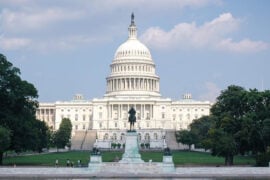The US Government continues to implement measures intended to restrict the provision or use of Chinese-origin goods and technology. Notably, on July 14, 2020, three government agencies issued an interim rule (the “Interim Rule”) that implemented changes to the Federal Acquisition Regulations (“FARs”) pursuant to Section 889 of the National Defense Authorization Act of 2019 (the “NDAA”). These changes have the effect of prohibiting not only the provision of “covered telecommunication equipment or services” to the US Government produced by certain Chinese entities (e.g., Huawei), but also the use of such items by US Government contractors.
We have provided below an overview of NDAA Section 889 and the implications this rule may have on US Government contractors operating within global supply chains.
Overview of NDAA Section 889
The NDAA was signed into law on August 13, 2018, and includes a number of provisions that were meant to increase national security of the United States through various regulatory reforms. These measures included, but were not limited to, increased scrutiny over foreign investments; the establishment of new export controls for emerging and foundational technologies; and increased sanctions on Russia. Baker McKenzie has provided updates on certain of these measures that have impacted export controls and sanctions measures on our Sanctions Blog.
NDAA Section 889 outlines prohibitions relevant to certain telecommunications and video surveillance services or equipment. Section 889(a)(1)(A) (“Part A”) and Section 889(a)(1)(B) (“Part B”) restrict the provision to the US Government, and the use by US Government contractors, of “covered telecommunications equipment or services” as a substantial or essential component of any system, or as critical technology as part of a system. “Covered telecommunications equipment or services,” as defined in the NDAA, includes:
- Items produced by Huawei Technologies Company or ZTE Corporation (or any subsidiary or affiliate of those entities);
- Products of certain video surveillance products or telecommunications equipment and services produced or provided by Hytera Communications Corporation, Hangzhou Hikvision Digital Technology Company, or Dahua Technology Company (or any subsidiary or affiliate of those entities);
- Telecommunications or video surveillance services provided by any of the above; and
- Telecommunications or video surveillance equipment or services produced or provided by an entity that the Secretary of Defense reasonably believes to be an entity owned/controlled by, or otherwise connected to, the Chinese government (collectively, “Covered Equipment”).
Part A
Part A, which restricts the provision of Covered Equipment, went into effect last year on August 13, 2019, and resulted in three amendments to the FARs, including: (i) prohibiting the procurement of such equipment (52.204-25); (ii) requiring every “offeror” to represent, prior to award, whether or not it will provide such equipment (FAR 52.204-24); and (iii) mandating that contractors report any such equipment discovered during the course of contract performance (FAR 52.204-25).
Part B and the Interim Rule
Part B, which has caused greater headaches for US Government contractors because of its broader reach, was recently implemented via an Interim Rule on July 14, 2020 and went into effect on August 13, 2020. The Interim Rule dictates that US Government agencies may not enter into a contract with an entity that uses Covered Equipment as a “substantial or essential component” of any system or as critical technology as part of a system. More specifically, contracting officers are required to include a representation regarding the use of Covered Equipment by prime contractors in all solicitations for an order, or notices of intent to place an order. Contractors or “offerors” are then required to certify as to the use or non-use of Covered Equipment.
It is not necessary that the Covered Equipment be used as part of the contract with the US Government to fall within the scope of the prohibition; rather, it is sufficient only that the offeror uses Covered Equipment as part of its overall business, making the breadth and applicability of this rule quite wide.
We have outlined below questions that US Government contractors can ask themselves to determine whether the Interim Rule applies to them and, if so, additional steps they can take to comply with the rule.
- Is your company an offeror? Unlike some other FARS provisions which require a flow down to affiliates or subcontractors, this particular provision applies only to the entity that signs the agreement with the US Government. However, we understand that rulemakers are considering expanding the scope of the prohibition to include “any affiliates, parents, and subsidiaries of the offeror that are domestic concerns.”
- If so, has your company conducted a reasonable inquiry into whether it uses Covered Equipment? The Interim Rule requires the prime contractor to engage in a “reasonable inquiry” to determine whether or not it uses Covered Equipment. A “reasonable inquiry” is one that is designed to uncover any information in the entity’s (i.e., the offeror’s) possession about the identity of the producer/provider of covered telecommunications equipment or services used by the entity and does not need to include an audit.
- If Covered Equipment is discovered, is the Covered Equipment a substantial or essential component of any system? The term “substantial or essential component of any system” means any component necessary for the proper function or performance of a piece of equipment, system or service. If Covered Equipment meets this threshold, further review will need to be undertaken to determine whether an exception applies. If no exception applies, your company may consider seeking a waiver from the US Government, the application for which will need to include a phase-out plan and complete layout of the presence of the Covered Equipment.
- If no Covered Equipment is discovered, has your company taken compliance steps to ensure no Covered Equipment is involved? The Interim Rule also offers six “contractor actions needed for compliance” in order to stay compliant with the Interim Rule. These include: (i) regulatory familiarization; (ii) corporate enterprise tracking (i.e., determining whether Covered Equipment is used by your company, your affiliates, or your subcontractors); (iii) education of purchasing/procurement departments; (iv) the cost of removing Covered Equipment if identified; (v) providing representations to the US Government regarding whether Covered Equipment is used and alerting the US Government if discovered during performance; and (vi) a cost to develop a phase-out plan for those entities that discover Covered Equipment.
Implications for Supply Chain Monitoring
The Interim Rule is already having a significant impact on how US Government contractors (including companies seeking to do business with US Government agencies) monitor their supply chains and the subcontractors operating within their supply chains.
As discussed above, Part B of the Interim Rule requires a US Government contractor to certify that it does not use “Covered Equipment” as a substantial or essential component in its overall business. In order to make the required certification, contractors that utilize and depend on goods produced by entities in their supply chains will need to implement measures that are designed to assess whether these goods are made of the prohibited equipment or services. While a supply chain audit is not required to make this assessment, a “reasonable inquiry” is so required.
Unfortunately, specific guidance has not been provided as to what a reasonable inquiry under the Interim Rule looks like or should consist of. However, we believe the following due diligence will probably be sufficient to meet this standard, at least for now:
- Identify the telecommunications equipment and services that are used in your business operations;
- Make an initial assessment of whether those items were made in China;
- If those items were made in China, identify which entity/entities within your supply chain provided you with the items at issue; and
- Submit a questionnaire to the identified entity/entities that asks targeted questions to determine whether the items fall within the scope of the prohibited equipment under the Interim Rule (e.g., were the items produced by Huawei Technologies Company or ZTE Corporation?).
Monitoring the production of goods in your supply chain to ensure they do not originate from certain countries or are not made of certain products can be an arduous undertaking. While the above-listed steps will not guarantee compliance with the Interim Rule, they likely meet the “reasonable inquiry” requirement and may help reduce a company’s overall liability exposure under the rule.




